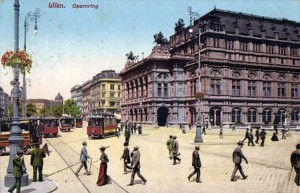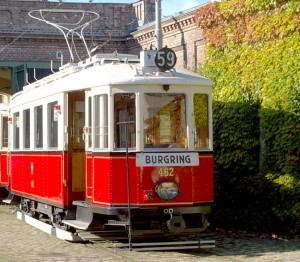Researching pre-Anschluss Vienna for her dramatic sequel, Annette saw something puzzling – the trams seemed to change from left to right in the same streets. How could this be?

Strassenbahn electric trams in 1910 in Vienna’s Opernring, exactly as violinist Phoebe Raye’s father would have known them before the Great War.
(Public domain)
Today Vienna has about 200 km of tramways. At its peak in 1930 there were an astounding 318 km of tram lines, which had been progressively electrified from 1897, replacing horse-drawn and steam trams. During the 1920s they became a unified municipal electric tram network, using the English convention of driving on the left.
But Nazi Germany’s March 1938 annexation of Austria was to bring myriad impacts on daily life.
On 19 September 1938, Hitler made Vienna’s trams change direction and run on the right, just like German ones.
Seven-year-old Kurt Fuchel describes how his life in Vienna was disturbed by everything, before the Kindertransport program saw him whisked away to safety in England:
Today the tram conductor said a bad word. He pulled the bell on the wrong side of the tram, so that it rang in the back instead of the front.
The trams used to run on the left side, now they run on the right.
I talk to all the people on the tram and tell them the bad things Herr Hitler has done, like telling Papa he can’t work in the bank any more. … I can’t go to school alone any more. People on the tram were angry that I was saying bad things, so now Papa takes me to school and back home. We don’t talk while we’re on the tram, but when we walk in the woods he tells me that people will be very angry if I say bad things about Herr Hitler. “But he is a bad man,” I say. Papa nods but doesn’t say anything.
– kindertransport.org/voices/fuchel_vienna.htm
During the Second World War, bomb-damaged Viennese tramways were progressively shut down, until the final battle for Vienna in April 1945 closed the last one.
After the War, lines were rebuilt and replacement trams brought in, some from America.
Vienna’s modern city tram network has 29 lines, and remains the fifth largest in the world.




